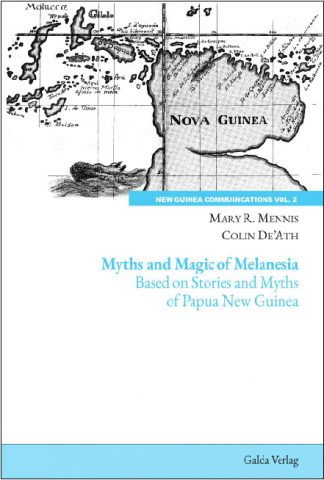Description
Professor Colin De’Ath and Mary R. Mennis were both doing research in the Madang area in the 1970s. While Professor Colin was working on the Gogol area researching the effects of the Trans-Gogol Timber Project on the local villagers, Mary Mennis was doing research into the culture of the coastal Madang people and changes that had occurred over the years. At that time, they collaborated and published »Merging Men and Nature: Myths of Melanesia«. The original version was published in Oral History in 1981, and recently it was decided to republish these myths to make them available to a wider readership. In this latest edition, a few modifications have been made to make the stories clearer. Also some myths and oral traditions have been added.
The myths presented in this book are from Madang, Manus Island, the Sepik area, the Highlands, New Britain and the Port Moresby area of Papua New Guinea as well as two from Irian Jaya. They are grouped under categories like Origin of Pottery, Two Brother Myths; Myths about mountains and Origin Myths for ease of comparison.
About the author
Mary Mennis has a Masters Degree in History from UPNG and a Masters Degree in Social Science from James Cook University. She was an Honorary Research Assistant at Queensland University for many years. Her research in Madang is also found in the book: “A Potted History of Madang: Traditional Culture and Change on the North coast of Papua New Guinea” published in 2007. During their time in Madang, Mary developed a deep appreciation of the culture of the village people and her family attended many gatherings and feasts.
Professor Colin De’Ath was born in New Zealand and later moved to Canada where he studied at the Faculty of Environmental Studies, University of Waterloo, Ontario. In the 1970s he volunteered with the Canadian Overseas Services and became a citizen of Papua New Guinea. He studied the influence of the Jant timber industry over the culture of the Gogol people near Madang PNG and wrote extensively on this subject. Colin subsequently worked with the Manus government and later moved to Thailand where he worked with the Overseas Education Department.
About the Series
The aim is to provide a conduit for the publication of studies on the Island of New Guinea, with its two established political divisions, but will also include other associated patterns of islands.
It will enable contributions from new knowledge workers—with their dissertations—and from established scholars. As there are numerous scholars who would like better coverage of the areas in which they have explored—as a tribute to the people they have worked with—as well as local scholars who understand the importance of their unique areas. It is felt that the approaches being trialed in the visual anthropology part of the series as area studies will bring a wider attention to the remarkable nature of the island.
The first volumes will be on modes of communication: oral history and folklore, and the emergence of a local literature. While the representation of all disciplines is welcome, comparative and whole island studies would be of great interest as well. For this, collaborative works or edited volumes may be needed.
It will allow for academic publications of a more preliminary kind—rather than exhaustive monographs, which are becoming more and more impossible to produce.
Where is the knowledge we have lost?


